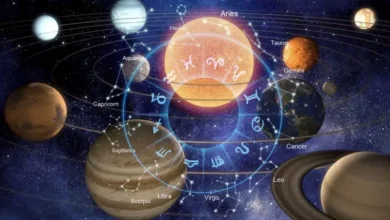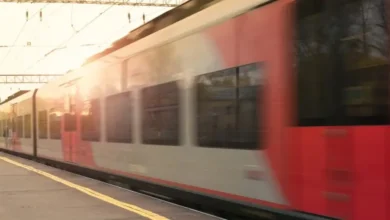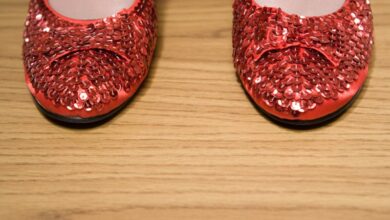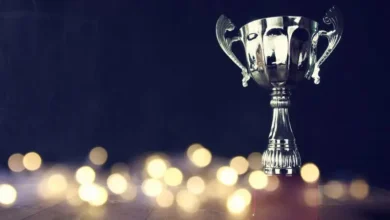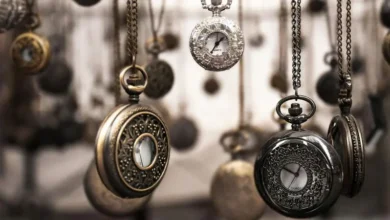Nasir Nasrallah’s ‘Poetic of Machines’: An ongoing communication between real, unreal
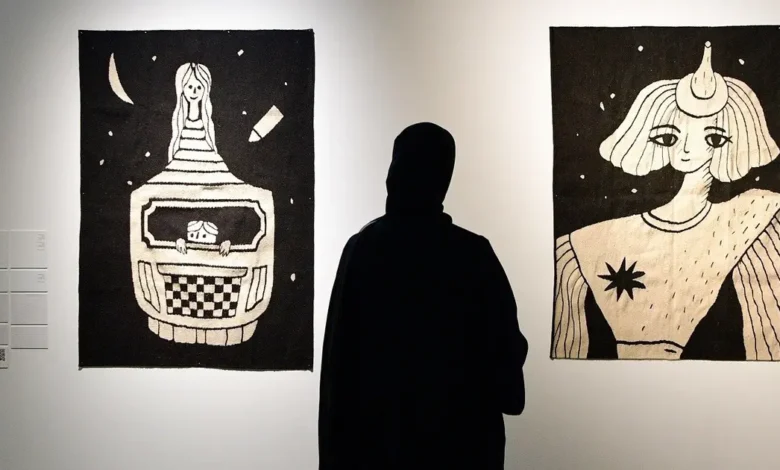
Emirati artist Nasir Nasrallah’s solo exhibition titled ‘Poetic of Machines,’ will long be remembered for unfolding before the viewer a new hybrid world populated by machines and human beings, where emotions and philosophical musings are delicately balanced against mechanical precision.
Currently underway at 421 in Abu Dhabi, each work in the exhibition will surprise you with its novelty and sense of juxtaposition, where humans – adults and children alike – transform and merge with toy-like objects, gadgets, and machines.
“I think my work is a mix of the real and unreal, and it’s an ongoing communication between these two realms,” says Nasrallah to Al Arabiya English. For the present exhibition, he says he created works around what he calls ‘Living Machines.’
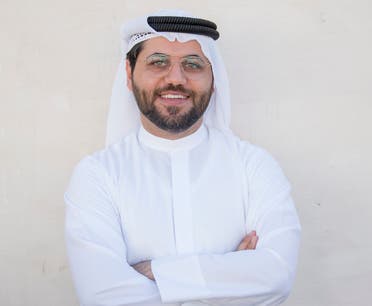
“In most of these works, the conversation takes place between machine to machine, human to machine, and human to human. I like to bring a certain kind of alternative reality into my work and make people think about this interaction, and also make it more interactive. It is as if I am giving a second life to this fax machine, used frames, and mirrors.”
Keen observers will also note the element of fun and humor that runs through Nasrallah’s work.
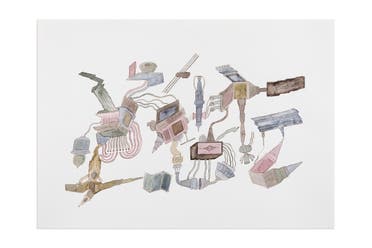
In this exhibition too, one can discern a series of funny conversations between these machines, and as Nasrallah readily agrees, “some of them do not make any sense, and some of them are a bit poetic. I like to dabble in such kind of conversations sometimes.”
Self-taught artist
Nasrallah traces his evolution as an artist while speaking to Al Arabiya English. “I started my foray into art during 2002-2003 by enrolling in art classes at the Emirates Fine Arts Society in Sharjah, because after studying Telecommunications Engineering at Khalifa University, I wanted to do something creative at that time. I got stuck with art since then. In that way, I consider myself a self-taught artist.”
Nasrallah also owes his love for art to his late grandfather Mohammed Nasrallah Alzarooni, a pioneer who established the Gulf Antiques shop in 1962.
“My family is known for collecting things. I grew up in my grandfather’s house that was like a museum. I think this influenced me a lot as an artist. And I have dedicated this exhibition to him.”
He recalls growing up being influenced by life and stories around him, and describes himself as someone “who lived on the inside, more than the outside.”
That is why Nasrallah considers that most of his works can be termed ‘fantasia’ or ‘surreal,’ and do not relate to the real world.
Commenting about his personal life, he says that for his children, “growing up with an artist father is a different experience” from that of his own in that he had a father who was a banker. “So, I can understand the difference!”
Having an education background in Telecommunication Engineering, Science Fiction has been a major influence in his life, and elements of that are very much visible in ‘Poetic of Machines.’
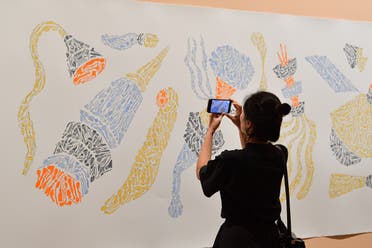
Some of the works in the show will evoke images from the Sci-Fi classic ‘2001: A Space Odyssey’ (1968).
Steeped in technical knowledge as well as in rich personal imaginative material, Nasrallah has created his own universe. He has struck a rich mine of creativity which can be spun off in the coming years into various forms of media. The possibilities are indeed many.
In ‘Space 2022,’ (acrylic on canvas) it is a starless space with Nasrallah’s machines floating around. These machines, with their soothing colors, may look familiar, drawn as they are from domestic surroundings – but they are uniquely the artist’s very own.
‘The Comet’ (wool tapestry) has a kind, female visage and the tail is not blazing, with fingers extended in a benign gesture, and the slivers of crescent moon shapes seem to be distant participants in the celestial spectacle.
‘The girl with a star’(wool tapestry) is a surreal creation of a girl carrying an intriguing expression, wearing a jumper with a star, and looking at us through eyes that are too large to be contained within the outline of her face. The absurdist nature of this comic drawing is inspired by Nasrallah’s fascination for the work of late Japanese artist Maki Sasaki.
Another similar work is ‘The boy in a living machine’ (wool tapestry), with the boy shown looking out of a floating living machine with a friendly female figure gracing the top of the contraption. A chess board like design adorns the outside of the machine and there are shapes hovering in the background space.
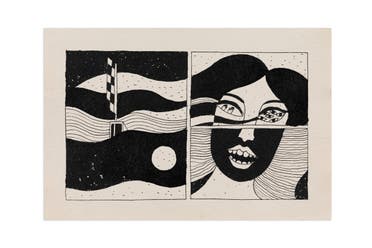
The LED and acrylic signs ‘Supporting Randomness’ and ‘Resisting Logic’ are further pointers on how to approach the artist’s work.
‘The Interaction’ depicts a world of objects, seemingly connected to each other but in effect not very usable – a reference to the futility of material accumulation, a theme which reminds us about the work of veteran Emirati conceptual artist, late Hassan Sharif.
‘In Rotation,’ the artist arranges these funny contraptions in a kind of ritual community dance.
A world where we share a symbiotic relationship with our tools is depicted in ‘The previous thinking of the living machines,’ and fuses the artist’s new machine-oriented thinking and his previous practice creating comic images.
‘The Comic of nonsense events,’ (Ink on paper, 18 pieces) shows a clear influence of the late Japanese artist Sasaki and his absurd imagery. Here, some of Nasrallah’s machines are floating alone in space, while in other works, human figures and forms, along with the machines and gadgets merge or share the same space in a cryptic mode of communication.
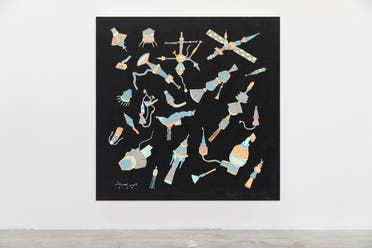
‘The journey of living machines that are floating somewhere 01-02’ (ink and water color on paper) focuses on mechanical details, in a reference to the early inventions during the Islamic Golden Age that predated the achievements of European science.
In ‘The second life of used frames 01-07’ (Pencil and marker colors on paper, used frame), Nasrallah examines the delicate forms of his floating living machines more closely and lovingly, like that of a Botanist examining an ‘autonomous life form.’
‘The Mirror that does not reflect you only’ is another brilliant work where the viewer is inevitably drawn into the world of Nasrallah’s floating living machines. Painted with acrylic ink on a mirror in an antique wooden frame, the interactive work allows us to temporarily become part of the artist’s universe.
In the interactive work ‘Faxes to myself,’ Nasrallah sends faxes to himself from his studios. Stories, illustrations, and other ideas are exchanged back and forth before being filed in the cabinet on the wall. The back and forth messages represent a sort of conversation and story-telling for the artist.
Handwritten whimsical short stories and drawings are collected in ‘Short stories in the brown sketchbook.’ These stories are short, philosophical and serve as potent modes of communication bridging disparate places and times.
A very optimistic future
Nasrallah is the Special Projects Manager at the Sharjah Art Foundation for ‘Corniche,’ an annual comic anthology compiling the works of around 40 illustrators and comic book artists from the UAE.
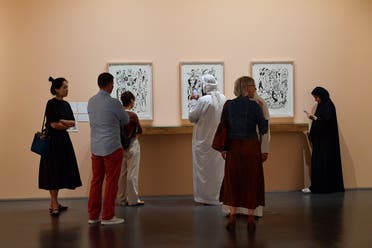
The publication, which is entering its fifth edition, has invited illustrators and comic artists from the wider GCC region to submit works for a range of genres to be published together, including biography, science fiction, fantasy, mythology, and art history.
Nasrallah is a recipient of the 2023 cycle of the 421 Artistic Development Program, and ‘Poetic of Machines’ is a result of the program organized in partnership with pedagogical partner the Institute for Emerging Art.
“This Artistic Development Program at 421 aims to provide UAE-based emerging artists with the opportunity to sustain a rigorous art practice, allowing them the space to continue to experiment,” says Jolaine Frizzell, Institute for Emerging Art, in comments to Al Arabiya English.
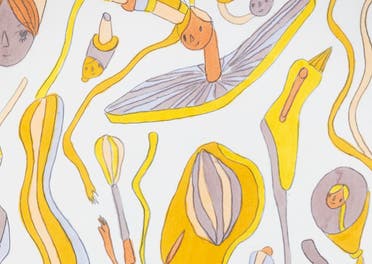
“Nasir and I met throughout the year to discuss his ideas, plans, and more and how he was going to install his exhibition. We also met with his mentor Adel Khozam.”
“We are very proud of Nasir’s exhibition. He wanted to bring a little of his studio and personality into the show. This is why you have the sofa and the plants and the fax machine. This interactivity — sending him faxes, receiving faxes from him, or sharing conversation on the couch — was very important. His machines are very comfortable. Unlike Science Fiction movies, you are not scared of his machine space. It shows a very optimistic future.”
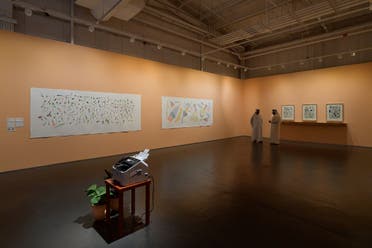
In the foreword of the show catalogue, Faisal Al Hassan, Head of 421, notes: “By highlighting the disordered roles of machines in our everyday lives, Nasrallah encourages us to reconsider the way we interact with and perceive the technological landscape that governs us.”
“…Nasrallah’s work opens up a meaningful regional discourse and revises the presentations and aesthetics around our cultural readings of technology, its impact on our lives, and its evolving relationship with history.”


